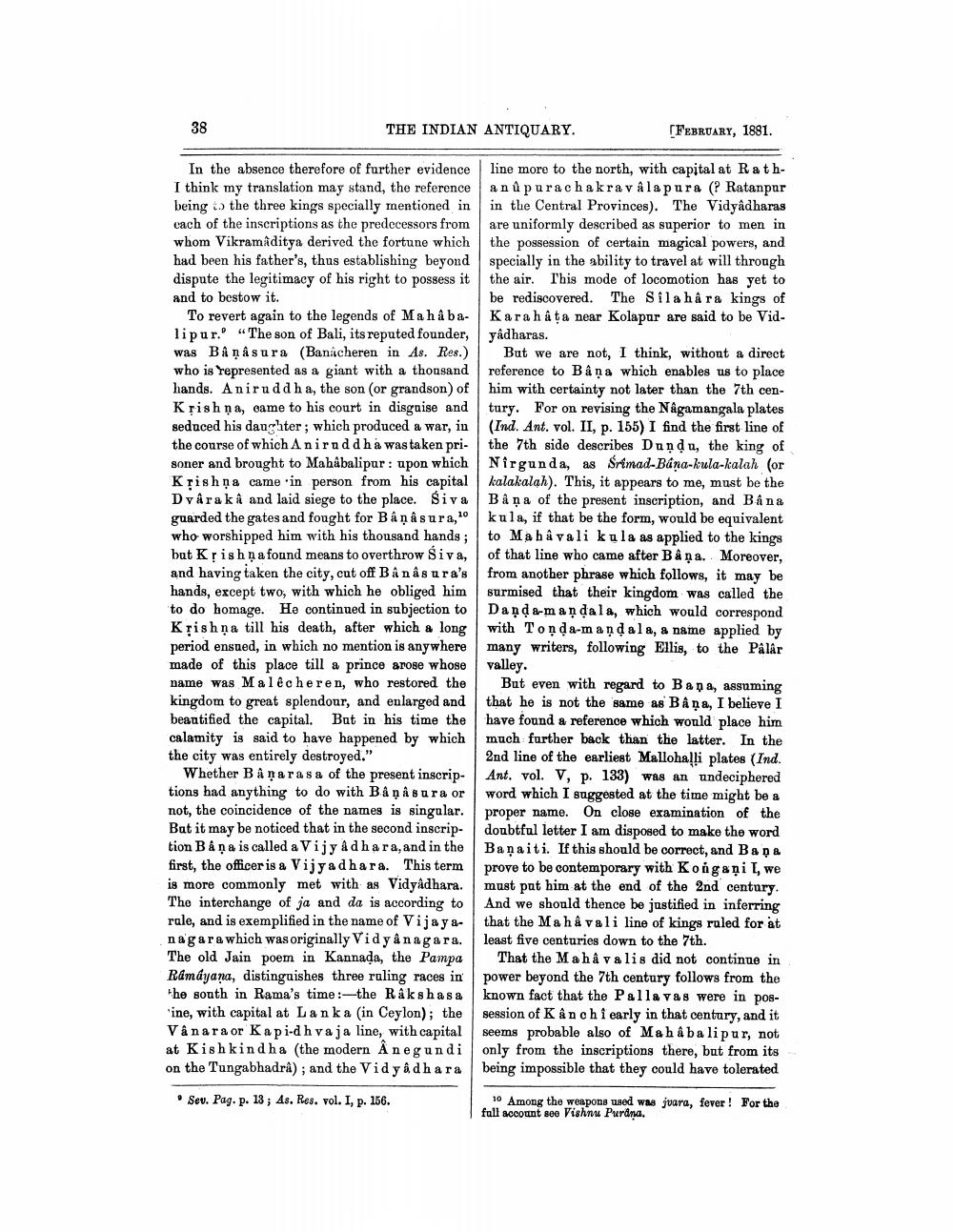________________
38
THE INDIAN ANTIQUARY.
FEBRUARY, 1881.
In the absence therefore of further evidence line more to the north, with capital at RathI think my translation may stand, the reference a nu pura chakra v alapura (? Ratanpar being in the three kings specially mentioned in in the Central Provinces). The Vidyadharas each of the inscriptions as the predecessors from are uniformly described as superior to men in whom Vikramaditya derived the fortune which the possession of certain magical powers, and had been his father's, thus establishing beyond specially in the ability to travel at will through dispute the legitimacy of his right to possess it the air. This mode of locomotion has yet to and to bestow it.
be rediscovered. The Sila hâra kings of To revert again to the legends of Mahaba-Karah å ta near Kolapur are said to be Vidlipur. “The son of Bali, its reputed founder, yâdharas. was Båņasura (Banacheren in As. Res.) But we are not, I think, withont a direct who is represented as a giant with a thousand reference to Bana which enables us to place hands. Aniruddha, the son (or grandson) of him with certainty not later than the 7th cenKrishna, came to his court in disguise and tury. For on revising the Någamangala plates seduced his daughter; which produced a war, in (Ind. Ant. vol. II, p. 155) I find the first line of the course of which Aniruddha was taken pri- the 7th side describes Dundu, the king of soner and brought to Mahabalipur: upon which Nirgunda, as Srimad-Bana-kula-kalah (or Krishna came in person from his capital kalakalah). This, it appears to me, must be the Dvâra kâ and laid siege to the place. Siva Båņa of the present inscription, and Bana guarded the gates and fought for B án â sura, kula, if that be the form, would be equivalent who worshipped him with his thousand hands; to Maha vali kula as applied to the kings but Krishņa found means to overthrow Śiva, of that line who came after Båņa. Moreover, and having taken the city, cut off Banâs u ra's from another phrase which follows, it may be hands, except two, with which he obliged him surmised that their kingdom was called the to do homage. He continued in subjection to Danda-mandala, which would correspond Krishna till his death, after which a long with Tonda-mandala, a name applied by period ensued, in which no mention is anywhere many writers, following Ellis, to the Palár made of this place till a prince arose whose valley. name was Malecheren, who restored the But even with regard to Bana, assuming kingdom to great splendour, and enlarged and that he is not the same as Bâņa, I believe I beautified the capital. But in his time the have found a reference which would place him calamity is said to have happened by which much further back than the latter. In the the city was entirely destroyed."
2nd line of the earliest Mallohalli plates (Ind. Whether B àņarasa of the present inscrip- Ant. vol. V, p. 133) was an undeciphered tions had anything to do with B & ņå sura or word which I suggested at the time might be a not, the coincidence of the names is singular. proper name. On close examination of the But it may be noticed that in the second inscrip- doubtful letter I am disposed to make the word tion B åņa is called a Vijyadhara, and in the Banaiti. If this should be correct, and Bana first, the officer is a Vijyadhara. This term prove to be contemporary with Kongaņi I, we is more commonly met with as Vidyadhara. must put him at the end of the 2nd century. The interchange of ja and da is according to And we should thence be justified in inferring rale, and is exemplified in the name of Vijaya- that the Maha vali line of kings ruled for at nagara which was originally Vidyanagara. least five centuries down to the 7th. The old Jain poem in Kannada, the Pampa That the Maha valis did not continue in Ramayana, distinguishes three ruling races in power beyond the 7th century follows from the "he south in Rama's time :-the Rakshasa known fact that the Palla vas were in pos'ine, with capital at Lanka (in Ceylon); the session of Kanch i early in that century, and it Vânara or Kapi-dh vaja line, with capital seems probable also of Mahabalipur, not at Kishkindha (the modern Å neg undi only from the inscriptions there, but from its on the Tungabhadra); and the Vidyadhara being impossible that they could have tolerated
• Sev. Pag. p. 13; As. Res. vol. I, p. 156.
10 Among the weapons used was juara, fever! For the fall account see Vishnu Purdna.




